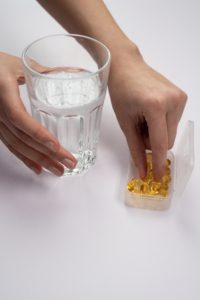Written by Taylor Woosley, Staff Writer. Comparison of incidence rates among healthcare workers including 255 subjects in the vitamin D3 intervention group and 578 controls revealed that vitamin D3 supplementation was associated with a lower risk of influenza-like illness (p = 0.0147).
 The COVID-19 pandemic has refocused attention on strategies to prevent acute respiratory tract infections1. Clinical symptoms of COVID-19 range from asymptomatic, through mild respiratory tract infections and influenza-like illness (mainly fever, cough, and fatigue), to severe disease with accompanying lung injury, multiorgan failure, and death2. Recent advances in the pathophysiological mechanisms that occur with COVID-19 have led to a growing interest to investigate the role of vitamin D and its deficiency to increase the susceptibility and negative results of COVID-193.
The COVID-19 pandemic has refocused attention on strategies to prevent acute respiratory tract infections1. Clinical symptoms of COVID-19 range from asymptomatic, through mild respiratory tract infections and influenza-like illness (mainly fever, cough, and fatigue), to severe disease with accompanying lung injury, multiorgan failure, and death2. Recent advances in the pathophysiological mechanisms that occur with COVID-19 have led to a growing interest to investigate the role of vitamin D and its deficiency to increase the susceptibility and negative results of COVID-193.
Vitamin D is an immunomodulator hormone and various studies have demonstrated a potential link between vitamin D deficiency and various diseases, including systemic infection4. Vitamin D can stall hyper-inflammatory responses via suppression of the adaptive immune responses in respiratory epithelial cells during viral infections5. Furthermore, vitamin D reduces the risk of the common cold through mechanisms in three categories: physical barrier, cellular natural immunity, and adaptive immunity6.
Helmond et al. conducted a pragmatic randomized clinical trial to investigate if daily vitamin D supplementation can prevent non-COVID-19 and COVID-19-related influenza-like illness (ILI) in healthcare workers. Study inclusion consisted of being a healthcare worker aged 18 years or older. Subjects were placed into either the intervention (vitamin D3) (n=255) or control group (n=578). Those in the intervention group received a daily dose of 5000 IU of vitamin D3 for 9 months.
Information regarding demographic characteristics, medical history, vitamin D deficiency history, COVID-19 history, as well as influenza and COVID-19 vaccination status was collected from all participants. Additionally, information regarding self-reported adherence to the daily vitamin D3 supplementation was also obtained from the intervention group. Primary outcomes included the incidence rate of ILI. Secondary outcomes included the incidence rate of COVID-19 ILI and non-COVID-19 ILI. Subjects in the intervention group were included in the statistical analysis if they completed at least 2 months of supplementation to allow for adequate vitamin D plasma levels. Comparison between the incidence rate of all ILI determined by PCR testing for COVID-19 conducted by employee health in the intervention and control group subjects was conducted to achieve the study aims.
In the intervention group, three workers had at least 1 episode of ILI, while 197 workers in the control group had at least 1 episode of ILI. Significant findings of the study are as follows:
- Comparison of incidence rates revealed that vitamin D3 supplementation was associated with a lower risk of ILI (p = 0.0147).
- A comparison of incidence rates revealed that vitamin D3 supplementation was associated with a non-statistically significant lower risk of COVID-19 ILI (p = 0.1517).
- A comparison of incidence rates revealed that vitamin D supplementation was associated with a lower risk of non-COVID-ILI (p = 0.0382).
Results of the study show that daily vitamin D3 supplementation reduces the incidence of ILI in healthcare workers. Furthermore, compared to the control group, the vitamin D3 supplementation group experienced a non-statistically significant lower rate of ILI due to COVID-19. Further research should continue to explore the effects of vitamin D3 on the reduction of COVID-19 symptoms and infections.
Source: van Helmond, Noud, Tracy L. Brobyn, Patrick J. LaRiccia, Teresa Cafaro, Krystal Hunter, Satyajeet Roy, Brigid Bandomer et al. “Vitamin D3 Supplementation at 5000 IU Daily for the Prevention of Influenza-like Illness in Healthcare Workers: A Pragmatic Randomized Clinical Trial.” Nutrients 15, no. 1 (2023): 180.
© 2022 by the authors.Licensee MDPI, Basel, Switzerland. This article is an open access article distributed under the terms and conditions of the Creative Commons Attribution (CC BY) license (https://creativecommons.org/licenses/by/4.0/).
Click here to read the full text study.
Posted March 23, 2023.
Taylor Woosley studied biology at Purdue University before becoming a 2016 graduate of Columbia College Chicago with a major in Writing. She currently resides in Glen Ellyn, IL.
References:
- Jolliffe DA, Holt H, Greenig M, et al. Effect of a test-and-treat approach to vitamin D supplementation on risk of all cause acute respiratory tract infection and covid-19: phase 3 randomised controlled trial (CORONAVIT). Bmj. Sep 7 2022;378:e071230. doi:10.1136/bmj-2022-071230
- Synowiec A, Szczepański A, Barreto-Duran E, Lie LK, Pyrc K. Severe Acute Respiratory Syndrome Coronavirus 2 (SARS-CoV-2): a Systemic Infection. Clin Microbiol Rev. Mar 17 2021;34(2)doi:10.1128/cmr.00133-20
- Barrea L, Verde L, Grant WB, et al. Vitamin D: A Role Also in Long COVID-19? Nutrients. Apr 13 2022;14(8)doi:10.3390/nu14081625
- Ali N. Role of vitamin D in preventing of COVID-19 infection, progression and severity. J Infect Public Health. Oct 2020;13(10):1373-1380. doi:10.1016/j.jiph.2020.06.021
- Mohan M, Cherian JJ, Sharma A. Exploring links between vitamin D deficiency and COVID-19. PLoS pathogens. Sep 2020;16(9):e1008874. doi:10.1371/journal.ppat.1008874
- Grant WB, Lahore H, McDonnell SL, et al. Evidence that Vitamin D Supplementation Could Reduce Risk of Influenza and COVID-19 Infections and Deaths. Nutrients. Apr 2 2020;12(4)doi:10.3390/nu12040988
